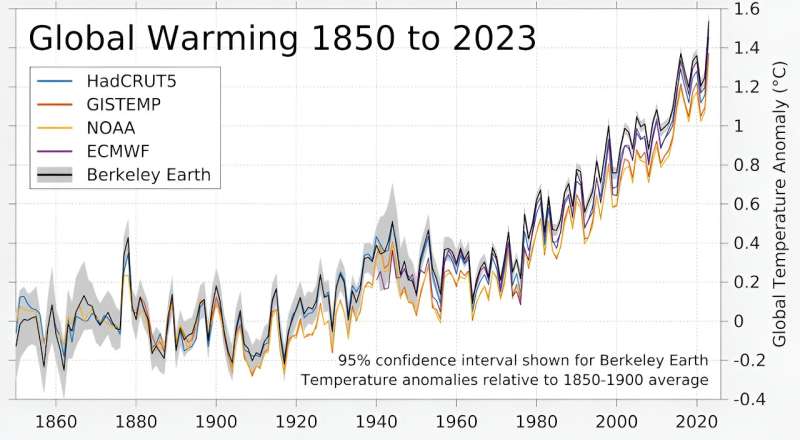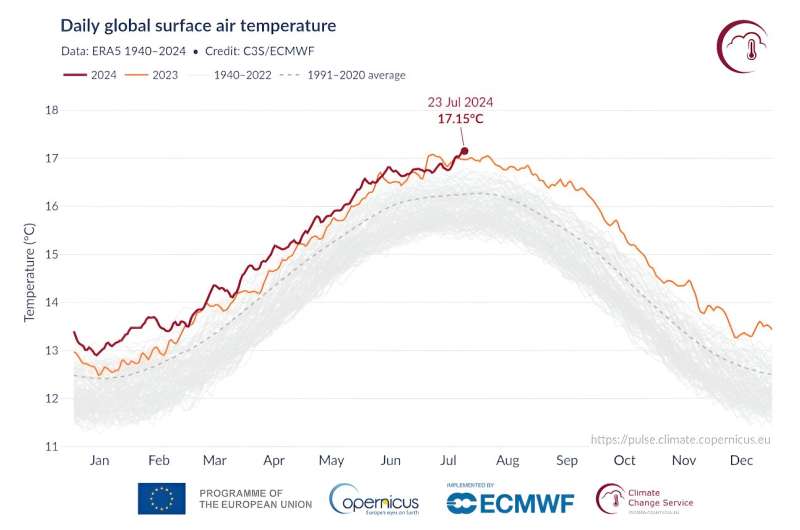This article has been reviewed according to Science X's editorial process and policies. Editors have highlighted the following attributes while ensuring the content's credibility:
fact-checked
trusted source
written by researcher(s)
proofread
Monday was the warmest day recorded on Earth, but how do scientists actually measure that?

In the past week, Earth's record for the hottest day was broken twice. Sunday July 21 was declared Earth's hottest day since records began, when average surface temperature reached 17.09°C. On Monday the record fell again, when average temperatures reached 17.16°C—and Tuesday was almost as hot.
The declarations were made by Copernicus, the European climate change service. They made international headlines—especially in the northern hemisphere, which has been experiencing extreme summer heat.
Determining the global average temperature on any given day is complex. It involves thousands of observations using high-tech equipment and in some cases, sophisticated computer models.
So let's take at look at how scientists take the planet's temperature, and what these broken records mean.
How we know it's hot
The global average surface temperature is the main indicator used to track how the climate is changing, and the measure used under the Paris Agreement.
It is derived from a combination of both the average temperature of air just above the land surface and in the upper layer of the ocean.
Several organizations develop estimates of Earth's average surface temperature using a variety of methods. Aside from Copernicus, they include national organizations in the United States, the United Kingdom and Japan.
All datasets produced by these agencies point to a very clear warming trend since 1900.
Most datasets are based on directly observed temperatures from weather stations on land and floats on the ocean, both of which contain thermometers. Satellites in space are also used to gather inferred estimates.
The advanced methods used today, and the many thousands of observations, mean daily temperature data is far more accurate than in years past. The further back in time we go, the more uncertain the estimates of global average surface temperatures.
What is Copernicus?
The Copernicus Climate Change Service is part of the European Union's Earth observation program. To generate its temperature estimates, Copernicus uses not just observations, but a computer model simulation.
The model simulates temperatures at 2 meters above the land surface everywhere across the globe. The results are combined with an estimate of oceans' average surface temperature derived from direct observation and satellite information.
Copernicus' use of information from a model simulation means its method differs slightly from other datasets. However, the method is well regarded and provides global estimates of average surface temperatures within a couple of days.

Unpicking the temperatures
We know the climate is changing at a rapid pace. But why is this record daily heat occurring now?
As the graph above shows, the global average surface temperature follows a distinct seasonal cycle. Temperatures in July are typically about 4°C higher than in January.
The difference comes down to the larger land masses of North America, Europe and Asia, as compared to those in the southern hemisphere.
Land warms up much more quickly than the ocean. By July each year, northern hemisphere land masses have usually heated substantially, while the southern hemisphere oceans are still slowly cooling. This means very high average global temperatures are only possible in northern summer and not the southern.
Still, the record high temperatures of this week are well beyond those seen before 2023. This is partly due to an El Niño—which typically brings hotter-than-average temperatures—and other factors such as high solar activity and reduced air pollution from falling shipping emissions.
Increased solar activity means the Earth receives more energy from the sun, while reduced air pollution can mean more energy from the sun reaches Earth's surface.
Crucially, these record-high temperatures would be all but impossible without the planetary warming caused by human-caused greenhouse gas emissions.
Global carbon dioxide emissions hit record highs last year. This means we are likely to see more heat extremes and record high temperatures in coming decades.
What's coming next
In April this year, experts declared the 2023/24 El Niño had ended. This is likely to lead to a slight cooling in global average surface temperature anomalies in coming months—albeit to levels still well above pre-industrial conditions. This is on top of the cooling as we move past the July peak discussed above.
Global average surface temperature is not the only indicator of global warming. For example, scientists also use sea level rise and glacier retreat to track climate changes. Other less formal observations, such as cherry blossoms in Japan blooming earlier, are also useful.
But no matter which indicator we use, the evidence is clear: Earth is getting hotter, and human activity is to blame.
The year 2023 was the hottest in modern records. There is a decent chance 2024 will be hotter still. Only when humanity greatly reduces its greenhouse gas emissions will the pace of record-breaking temperatures slow.
Provided by The Conversation
This article is republished from The Conversation under a Creative Commons license. Read the original article.![]()



















